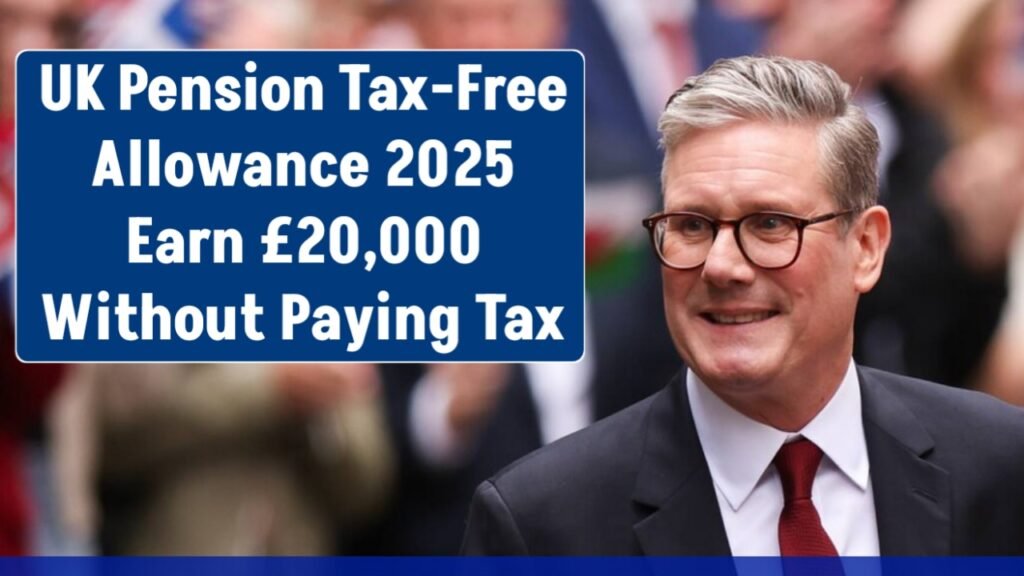Many UK pensioners are looking for ways to maximise their retirement income while avoiding unnecessary tax bills. In 2025, new rules and allowances mean that certain pensioners can earn up to £20,000 per year completely tax-free. This is excellent news for those relying on a mix of state pension, private pensions, and other income sources. Understanding how the tax-free pension allowance works can help you plan your finances better and keep more money in your pocket.
What Is The Pension Tax-Free Allowance?
The pension tax-free allowance is the amount of income you can earn each year without paying any income tax. For the 2025/26 tax year, the Personal Allowance in the UK remains at £12,570. This means that the first £12,570 of your income, whether from pensions, employment, or other sources, is tax-free. However, if you combine this allowance with the starting rate for savings and the Personal Savings Allowance, certain pensioners can boost their total tax-free earnings up to around £20,000.
How The £20,000 Tax-Free Limit Works
To reach the £20,000 tax-free figure, pensioners can take advantage of multiple allowances. The Personal Allowance covers the first £12,570. If you have savings interest, the starting rate for savings may allow up to £5,000 of interest to be tax-free, provided your other income is below a certain threshold. On top of that, the Personal Savings Allowance lets basic-rate taxpayers earn an extra £1,000 in savings interest without paying tax. Some pensioners may also qualify for the Dividend Allowance if they hold shares. Combining these allowances can push the total annual tax-free income to around £20,000.
Who Qualifies For This Tax-Free Income?
Not all pensioners will qualify for the full £20,000 tax-free amount. You must be within the basic income threshold and meet the eligibility rules for the different allowances. Pensioners with a modest private pension, state pension, and some savings are the most likely to benefit. For example, if your state pension is around £11,500 per year, you could still have tax-free savings interest and dividend income to bring your total up to the limit. Higher-income pensioners, or those who receive large occupational pensions, may not be able to take full advantage.
State Pension And The Allowance
The UK state pension counts as taxable income, even though it is paid without tax deducted at source. For most pensioners, the state pension alone will not exceed the Personal Allowance. However, when combined with other income like workplace pensions or part-time earnings, it could push you over the tax-free limit. The 2025 state pension rates mean that those on the full new state pension will receive just over £11,500 per year, leaving room for other income streams to stay within the tax-free allowance.
Tax On Private And Workplace Pensions
Private pensions and workplace pensions are also counted as taxable income. However, when you first access a pension pot, 25% of it can usually be taken as a tax-free lump sum. For those taking regular income from a pension, keeping withdrawals low enough to stay under the tax-free limit can reduce or eliminate income tax bills. This requires careful planning, but it is one of the most effective strategies for maximising your net retirement income.
Impact Of Savings And Investments
Savings interest, dividends, and investment income can all be received tax-free if they fall within the relevant allowances. For example, using an ISA (Individual Savings Account) allows pensioners to earn tax-free interest or investment growth without affecting their Personal Allowance. Pensioners with money in tax-efficient accounts like ISAs can use these to top up income without triggering tax liability, helping to reach the £20,000 total tax-free earnings target.
How To Claim Your Tax-Free Allowance
You don’t have to make a formal claim for your Personal Allowance—it is automatically applied by HMRC. However, if you have multiple sources of income, you may need to contact HMRC to ensure your tax code is correct. Pensioners with savings or investment income may also need to complete a self-assessment tax return to confirm they are within the limits. Keeping accurate records of your income sources will help you avoid overpaying tax.
Example Of How It Works
Let’s take an example. A pensioner receives £11,500 from the state pension and £4,000 in private pension income. This totals £15,500, which is under the Personal Allowance plus savings allowance combined limit. If they also earn £3,500 in savings interest through ISAs and tax-free allowances, their total annual income would be £19,000 without paying any tax. By carefully managing income streams, they stay below the £20,000 tax-free threshold.
Planning Ahead For Retirement Income
Understanding the tax-free pension allowance is vital for retirement planning. Pensioners should review all income sources and check whether they are using available allowances efficiently. Financial advisers can help with pension withdrawal strategies, making sure you avoid unnecessary tax bills. Even small changes in how you draw your income can save hundreds or even thousands of pounds each year.
Potential Changes In The Future
While the current rules allow pensioners to earn up to £20,000 tax-free, tax thresholds can change with each government budget. The Personal Allowance has been frozen in recent years, meaning inflation reduces its real value over time. Pensioners should stay informed about any updates to the tax system to make sure they continue to benefit from the maximum possible tax-free income.
Final Thoughts
For UK pensioners in 2025, the opportunity to earn up to £20,000 tax-free can make a big difference to retirement finances. By combining the Personal Allowance with other tax-free allowances for savings and investments, many retirees can boost their income without paying tax. Careful planning and understanding the rules are key to making the most of this benefit and enjoying a more comfortable retirement.
